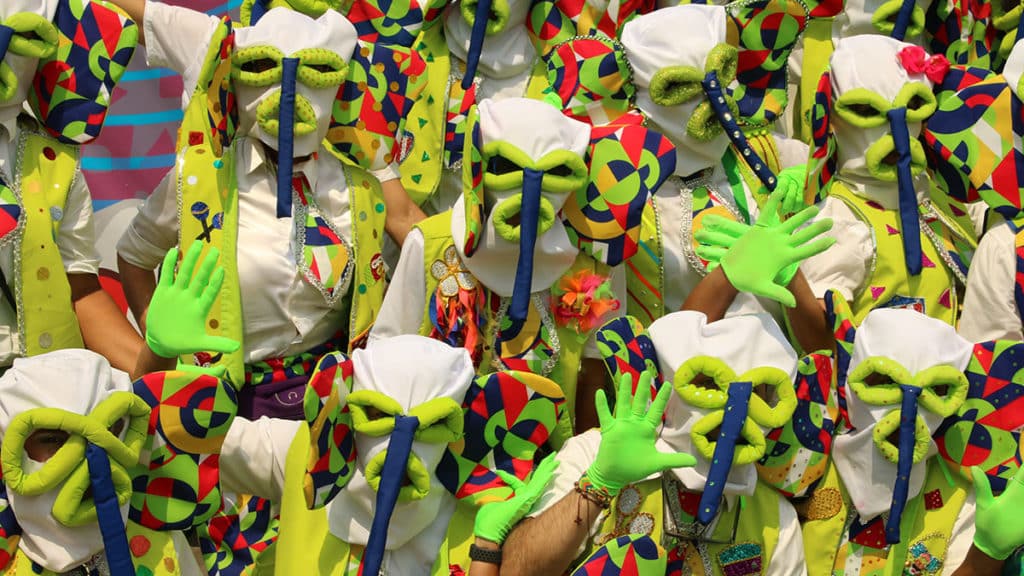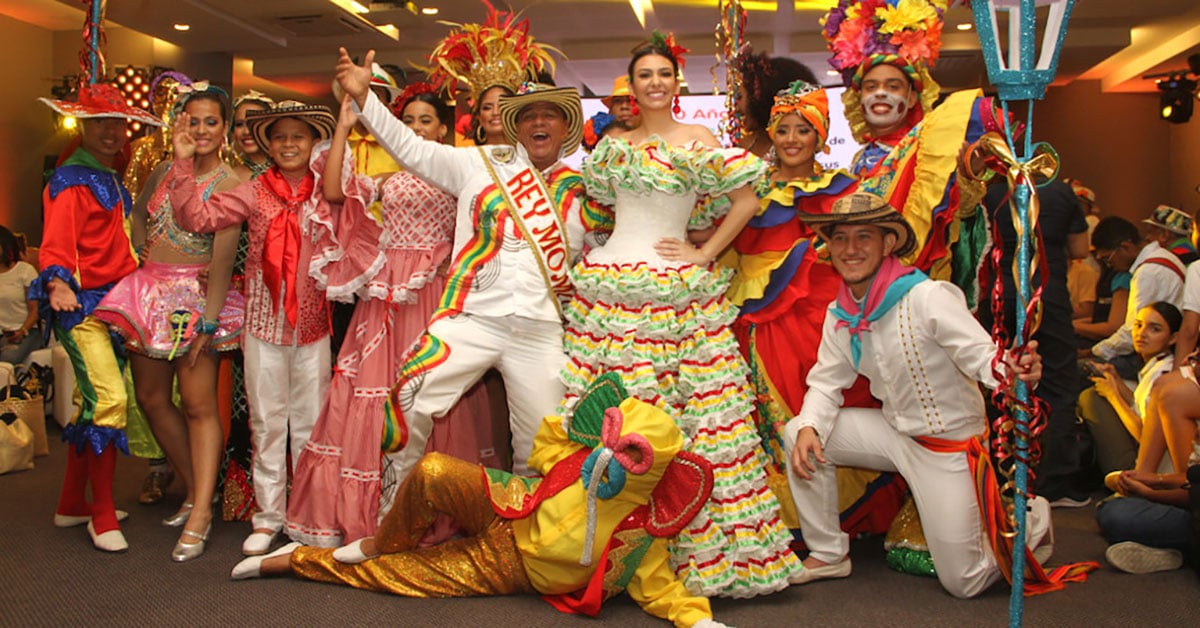Barranquilla Carnival is a Colombian expression of Caribbean Carnival traditions. It is the world’s second biggest Carnival celebration after Rio Carnival with over five hundred folk groups and more than a million and a half celebrants. It is also Colombia’s biggest festival.
In 2003, Barranquilla Carnival was proclaimed by UNESCO to be one of the Masterpieces of the Oral and Intangible Heritage of Humanity.
Important characters include King Momo, Carnival Queen, María Moñitos and Cayman Man. Marimonda is a uniquely Barranquilla character.
There are official events, but street parties break out in open areas called verbenas all over during Carnival month. Some of the most popular street parties are in El Bambú in Barrio Olaya, El Polvorín in Barrio San José, Pleno Sol in Barrio La Uníon, La Gustadera in Barrio Las Nieves, and La Puya loca in Barrio Los Pinos.
Barranquilla Carnival 2023

Barranquilla Carnival starts with a flag raising on Friday, January 6, 2023. It builds to a climax over Carnival Weekend, Saturday-Tuesday, February 18-21, 2023.
Barranquilla Carnival 2022
This schedule comes from the Barranquilla City Hall as of February 17.
March 1 ~ There is an art exposition of giant
Looking a year ahead during the COVID-19 Pandemic, nobody knows whether we will be able to celebrate Carnival, but the main events are scheduled for Saturday-Tuesday, February 26 – March 1, 2022. Pre-Carnival events start in early February.
Pre-Carnival
Preparations begin six months ahead, but get serious right after Christmas. Pre-Carnival begins the month before and builds up to Carnival Weekend and Carnival Tuesday. These are some of the main pre-Carnival events.
The Carnival Queen is usually selected in October the year before.
The Carnival Proclamation in La Paz square starts the festival.
Saturday, February 5 ~ Lectura del Bando
Thursday, February 17 ~ Carnival Queen Coronation is usually held in Romelio Martinez Stadium.
There are a Children’s Parade and a Gay Parade around these days.
Friday, February 18 ~ La Guacherna is a night parade that is the peak of Pre-Carnival. It’s song is the merengue “La Guacherna” by Esthercita Forero.
Carnival
Carnival Saturday, February 26 ~ Battle of the Flowers (Batalla de las Flores) parade with floats and folkloric groups. The tradition comes from 1903 as a celebration of the end of the Thousand Day War.
Carnival Sunday, February 27 ~ Great Parade of Tradition and Folklore (Gran Parada de tradición y folclore) with traditional folkloric groups.
Carnival Monday, February 28 ~ Great Parade of Comparsas which adds floats to the folkloric groups. The overnight Orchestra Festival presents a competition of carnival balls.
Carnival Tuesday, March 1 ~ The Burial of Joselito Carnaval symbolizes the end of the party and the idea that whatever happened at Carnival, stays at Carnival.
Barranquilla Carnival 2019
The 2019 theme is ¡Para que lo baile todo el mundo! (For everyone to dance!)
¡Para que lo baile todo el mundo! (For everyone to dance!)
There is a big buildup for the entire month before the parades which are the main event.
La Guacherna
This night parade gets things going on Friday, February 22.
Children’s Parade
The Children’s Parade is on Sunday, February 24.
Carnival Queen’s Coronation

Dancing in the street starts at 5pm. The Carnival Queen’s coronation is in Estadio Romelio Martinez on Thursday, February 28 at 8pm.
Colombian vallenato star Carlos Vives is invited. The 2019 Barranquilla Carnival Queen is Carolina Secebre Abudinen.
The first Carnival Queen was crowned over a hundred years ago in 1918.
Carnival Concert
The concert marks the beginning of the climax of Carnival.
This year’s Carnival concert features Marc Anthony, Silvestre Dangond, Peter Manjarrés, Checo Acosta and Trapical Minds in Estadio Romelio Martínez on Friday, March 1 at 8pm.
The Battle of the Flowers
The first Battle of the Flowers was held in 1903. This year it is on Via 40 on Saturday, March 2 at 12pm. The Parade runs for five or six hours.
The King Momo Parade is on Calle 17 at 2pm.
At 5pm there is comic theatre in Parque Metropolitano and dancing in the street.
Great Parade of Tradition and Folklore
This is sort of the people’s parade. It is all people without any floats. It features cumbia, folkloric and other dancing. Over 300 dancing groups march every year.
The Parade of Tradition and Folkore is on Via 40 on Sunday, March 3 at 1pm.
There is dancing in the street to a night of orchestras at Par Vial Car. 50 at 5pm.
There is comic theatre in Parque Olaya and spoken word in Barrio Abajo at 5pm.
Great Parade of Groups
This is the big showcase Parade. It has floats and more choreography. It is on Via 40 on Monday, March 4 at 1pm.
The fun starts with a festival of orchestras in Plaza de la Paz at 11am.
After the Parade, there is comic theatre in Parque Calancala at 5pm.
Joselito Leaves with the Ashes
Barranquilla Carnival ends with the ritual burial of Joselito, a character who symbolizes the joy and freedom of Carnival. It’s the equivalent of Fat Tuesday (Mardi Gras).
There is comic theatre in Parque Almendra at 2pm.
People march through the streets pulling Joselito in coffins or stretchers at Carrera 54 calle 58 at 4pm.
It’s a great party, Colombian style.
#PuraAlegria (Pure Joy)
Carnival
Carnival is a reverse-festival where social structures are turned upside down. Slaves had more freedom and masters had to give in a little.
It grew out of ancient farm-economy traditions in northern Italy. There was less work to do, beer from the previous season’s harvest, and meat slaughtered the previous fall had to be eaten before it spoiled. Hence “carne-va” (the meat goes).
Put that all together and you have the world’s biggest Latin party.
Old traditions have a certain logic. Many babies are conceived during Carnival. Carnival babies are born the next winter which avoids disrupting planting and harvest work.
The party builds up to Fat Tuesday. Ash Wednesday marks the beginning of Lent, the Catholic period of fasting and religious piety leading up to Easter. In a way we had to fast because we ate all the food from the previous harvest. Then we get serious and prepare to plant in the spring around Easter.
Barranquilla Carnival
Barranquilla Carnival is the world’s second biggest Carnival festival after Rio. Its origins are hidden by the mists of time, but Barranquilla Carnival goes back beyond at least 1888 when King Momo first reigned.
King Momo reigns over the land of dreams and the crazy. He protects Carnival-goers from harm and scandal. Colombia is a very conservative country, but when King Momo reigns, it’s okay to party (actually we always love to party).
The Festival’s slogan is “quien lo vive, es quien lo goza” (those who live it are those who enjoy it).
UNESCO, the UN cultural agency, declared Barranquilla Carnival a Masterpiece of the Oral and Intangible Heritage of Humanity in 2003.
Barranquilla
Barranquilla is a Caribbean city on the mouth of the Magdalena River, the great river of Colombia. It is a special place because unlike other Colombian cities, it was founded by local Caribs, Arawaks and Africans, not the Spanish colonizers.
Being at the mouth of the Magdalena gives Barranquilla a unique blend of influences from the Colombian interior and the Caribbean. Many places in Barranquilla still carry the names given them by the Mocaná, the biggest Indigenous group in the region.
Marimonda
Like many countries, Colombia has its own favorite Carnival characters. They often make fun of tough characters like devils, colonial masters and so on.
People prepare their Carnival costumes all year long. Marimonda was created by a fellow in Barranquilla who was too poor to afford a fancy Carnival costume so he made his own using old clothes and a bag.
Marimonda shakes his legs, waves his arms like a chicken, and dances like he is being attacked by ants. He is pure fun, Barranquilla style.
Barranquilla Carnival Tickets
The party is all over the streets, but you can buy tickets for seating at tuboleta.com
Palcos are box bleacher seats. Minipalcos are mini-box seats.
Traveling to Barranquilla
Book your travel and lodging early because Barranquilla fills up during Carnival and prices are higher.
Colombian/Latin American airline Avianca has the most options for flying from New York City to Barranquilla.
For more information, visit carnavaldebarranquilla.org
